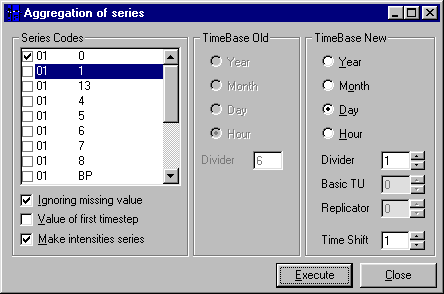Aggregation
Basic and Aggregated Series
The original series, i.e. the series to be aggregated, is called basic series. The series with the aggregates is called the aggregated series.
In aggregating series two cases are distinguished:
1. for instantaneous observations the aggregated data are averages of the originals, e.g. discharges in m3/s.
2. for accumulative observations the aggregated data are the sums of the originals, e.g. rainfall or runoff in mm.
Note that corrections are made for an unequal number of basic time units; for example when decade data are aggregated to monthly series.
- for instantaneous observations:
Yj = (1/n)(10 X1,j + 10 X2,j + (n-20) X3,j )
- for accumulative observations:
Yj = X1,j + X2,j + X3,j
where:
Xi,j
Yj
n
i-th decade of month j
j-th month
number of days in month j
Series Codes
The series to aggregate can be selected or de-selected by clicking the checkbox of the series. By clicking your right mouse button on top of the Series list box you can select or de-select all series.
Ignore Missing Value
If in an aggregate one or more basic series elements are missing, the aggregate will by default also become a missing value. When the 'Ignore Missing Value' checkbox is checked, the missing values will be ignored.
Value of First Time Step
When 'Value of first time step' is checked the aggregation values will be taken as the first value of the new time step When, for example, daily values are aggregated to monthly values, the aggregated monthly values will be equal to the first value of each month.
Make Intensities Series
This option is specially introduced for rainfall series with accumulated values. If a time series has accumulated values, HYMOS will first make an intensities series from it before the time series will be aggregated. This can be useful when the rainfall series has hourly accumulated values from 0:00 to 0:00 the next day and the user wants to compute aggregated values from 8:00 to 8:00.
Time Shift
The Time shift option is introduced to change the start time of the aggregated series, by default the time shift is 0. The time shift can be changed by using the spin button or by entering a value in the text box. The time shift values must be integer values, between -1000 and +1000.
This option can be useful when aggregating hourly rainfall values to daily values. When you aggregate hourly values from 1-1-2000 8:00 to 2-1-2000 8:00 the aggregated daily rainfall value will, by default, be set to 1-1-2000. In many countries the meteorological service uses a different procedure, the aggregated daily rainfall value is set to 2-1-2000. In HYMOS you can change the time shift to 1 when you want to follow this procedure.
The standard aggregation method in HYMOS looks back in time. While aggregating day values, the values of the past 24 hours are used. Other programs, like FEWS, perform their aggregation based on the next 24 hours. By selecting a time-shift of one with the unity of the timestep of the aggregated series in the aggragation window, the aggregation method in HYMOS can be changed. HYMOS will be looking at the next 24 hours while performing day aggregations.
To execute aggregation following entries/selections have to be made:
- Select one or more basic series from the Series Codes list.
- Select time intervals of aggregated series where Δtbasic < Δtaggregated
- Press <Execute> to execute the aggregation.
The newly aggregated series can be shown in a graph, viewed within the spreadsheet viewer, saved to the database or exported.
